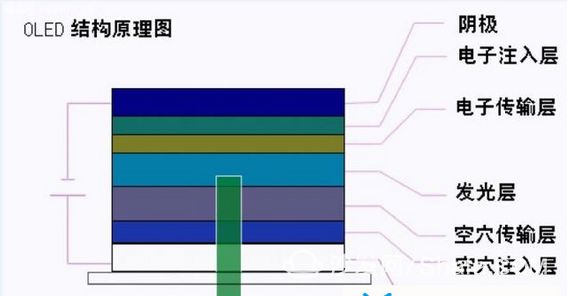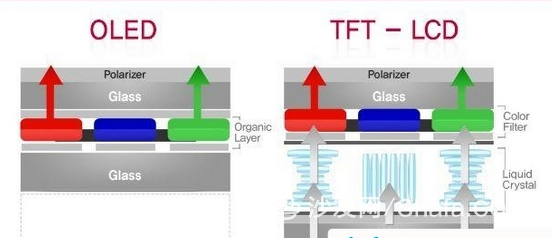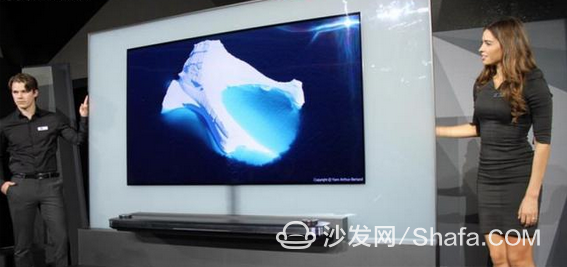Although the focus of this article is on OLED TVs, OLEDs have already been widely used outside the TV field. Apple's use of OLED screens on the iPhone 8 has now become an open secret. As the most promising next-generation TV display technology, it can be seen from CES 2017 that the popularity of OLED TVs is accelerating. In particular, Sony has released the OLED TV A1E for the consumer-grade market, which further strengthens the OLED camp. It is time to learn about OLEDs. TV.
1. What is OLED?
OLED is the abbreviation of Organic Light-Emitting Diode, translated as an organic light-emitting diode. This material was discovered accidentally by Professor Deng Qingyun of Chinese descent in 1979. He suddenly remembered that something was forgotten in the laboratory on his way home. So I went back and discovered that there was a bright light in the dark. It turned out to be an organic battery for experimentation. This led to an in-depth study of OLEDs.

OLED structure schematic
OLED's structure and light emitting principle are too complicated, and it does not take up space to introduce it. It only needs to know that OLED display technology is totally different from traditional LCD display mode. It does not need backlight, uses very thin organic material coating and glass substrate. When light passes through, these organic materials emit light.
2. What is the difference between OLED TV and LCD TV?
At present, LCD TVs in the market occupy an absolute market share, attention is not LED, LED refers to only the backlight, the screen body material is LCD, so it is called LCD TV. Compared with OLED TVs, whether or not the backlight is the most obvious difference between the two.

OLED and TFT-LCD structure comparison As can be seen from the figure above, the TFT-LCD emits light through the Backlight Unit, turns on and off through the liquid crystal control, and then displays different colors through different RGB color filters. The OLED uses organic light-emitting materials, which have self-luminous characteristics, so no backlight is needed.
3. What are the main advantages of OLED TVs?
Referring to OLEDs, self-luminous, high contrast, fast response, wide viewing angles and other characteristics make it the most optimistic about becoming the next-generation display technology. Although LCD TV display technology is constantly evolving and upgrading, it still cannot completely change the imaging principle. Congenital defects such as light leakage, smearing, etc., and these OLEDs can be perfectly solved.

The black field performance OLED has an absolute advantage because the OLED adopts the self-illumination body to emit light. When the black scene is displayed, all the self-luminous pixels are in a state of not emitting light, so the picture can be completely black, infinite black, corresponding to the LCD TV. There will be cases where the black sinking is not in place, and the LCD TV cannot completely block the light of the backlight, so light leakage or halo phenomenon is inevitable, which is particularly evident on the inexpensive LCD TV.

The faster the response speed, the better it can avoid ghosting and smearing.
No matter what kind of means or technology LCD LCD screen through can not fundamentally eliminate the phenomenon of residual image, which is related to the working mode of the LCD screen, liquid crystal molecular deflection response destined to take time, residual image is inevitable. OLED's response speed is far more than that of LCD, and it can be very smooth and clear when showing motion pictures. This is another technical advantage that OLED can't be overtaken by LCD TV.

OLED has an ultra-wide viewing angle
IPS hard screens in the LCD field are famous for their wide viewing angles, but they are also inferior to OLED TVs. The active light emission characteristics make the viewing angle of OLED panels close to perfect, and even the effects obtained from some extreme angles are basically the same. Because of this, the emperor's place in the living room lost its meaning.

LG SIGNATURE W7 affixed to the wall
Since no backlight is required, OLED TVs have an absolute advantage over LCDs in thickness. For example, LG's W series OLED TVs launched at CES 2017 are only 2.57mm thick. Due to the split-type design, they can be attached to a wall exactly like a painting. .
In addition, OLED can also realize flexible display, which can display various designs such as double-sided, curled, transparent, folded, wearable, etc. Therefore, in addition to applications in the television field, some smart devices including mobile phones have used OLED screens. , has a wide range of application scenarios in the Internet of Things era.
Smart TV/box information can focus on smart TV information network sofa butler (http://), China's influential TV box and smart TV website, providing information, communication, TV boxes, smart TVs, smart TV software, etc. Answering questions.
1. What is OLED?
OLED is the abbreviation of Organic Light-Emitting Diode, translated as an organic light-emitting diode. This material was discovered accidentally by Professor Deng Qingyun of Chinese descent in 1979. He suddenly remembered that something was forgotten in the laboratory on his way home. So I went back and discovered that there was a bright light in the dark. It turned out to be an organic battery for experimentation. This led to an in-depth study of OLEDs.

OLED structure schematic
OLED's structure and light emitting principle are too complicated, and it does not take up space to introduce it. It only needs to know that OLED display technology is totally different from traditional LCD display mode. It does not need backlight, uses very thin organic material coating and glass substrate. When light passes through, these organic materials emit light.
2. What is the difference between OLED TV and LCD TV?
At present, LCD TVs in the market occupy an absolute market share, attention is not LED, LED refers to only the backlight, the screen body material is LCD, so it is called LCD TV. Compared with OLED TVs, whether or not the backlight is the most obvious difference between the two.

OLED and TFT-LCD structure comparison As can be seen from the figure above, the TFT-LCD emits light through the Backlight Unit, turns on and off through the liquid crystal control, and then displays different colors through different RGB color filters. The OLED uses organic light-emitting materials, which have self-luminous characteristics, so no backlight is needed.
3. What are the main advantages of OLED TVs?
Referring to OLEDs, self-luminous, high contrast, fast response, wide viewing angles and other characteristics make it the most optimistic about becoming the next-generation display technology. Although LCD TV display technology is constantly evolving and upgrading, it still cannot completely change the imaging principle. Congenital defects such as light leakage, smearing, etc., and these OLEDs can be perfectly solved.

The black field performance OLED has an absolute advantage because the OLED adopts the self-illumination body to emit light. When the black scene is displayed, all the self-luminous pixels are in a state of not emitting light, so the picture can be completely black, infinite black, corresponding to the LCD TV. There will be cases where the black sinking is not in place, and the LCD TV cannot completely block the light of the backlight, so light leakage or halo phenomenon is inevitable, which is particularly evident on the inexpensive LCD TV.

The faster the response speed, the better it can avoid ghosting and smearing.
No matter what kind of means or technology LCD LCD screen through can not fundamentally eliminate the phenomenon of residual image, which is related to the working mode of the LCD screen, liquid crystal molecular deflection response destined to take time, residual image is inevitable. OLED's response speed is far more than that of LCD, and it can be very smooth and clear when showing motion pictures. This is another technical advantage that OLED can't be overtaken by LCD TV.

OLED has an ultra-wide viewing angle
IPS hard screens in the LCD field are famous for their wide viewing angles, but they are also inferior to OLED TVs. The active light emission characteristics make the viewing angle of OLED panels close to perfect, and even the effects obtained from some extreme angles are basically the same. Because of this, the emperor's place in the living room lost its meaning.

LG SIGNATURE W7 affixed to the wall
Since no backlight is required, OLED TVs have an absolute advantage over LCDs in thickness. For example, LG's W series OLED TVs launched at CES 2017 are only 2.57mm thick. Due to the split-type design, they can be attached to a wall exactly like a painting. .
In addition, OLED can also realize flexible display, which can display various designs such as double-sided, curled, transparent, folded, wearable, etc. Therefore, in addition to applications in the television field, some smart devices including mobile phones have used OLED screens. , has a wide range of application scenarios in the Internet of Things era.
Smart TV/box information can focus on smart TV information network sofa butler (http://), China's influential TV box and smart TV website, providing information, communication, TV boxes, smart TVs, smart TV software, etc. Answering questions.
Plastic Ptfe Plates,Sheet Ptfe Gasket,Plastic Ptfe Sheet ,Ptfe Plate
Cixi Congfeng Fluorine Plastic Co.,Ltd , https://www.cfptfeseal.com